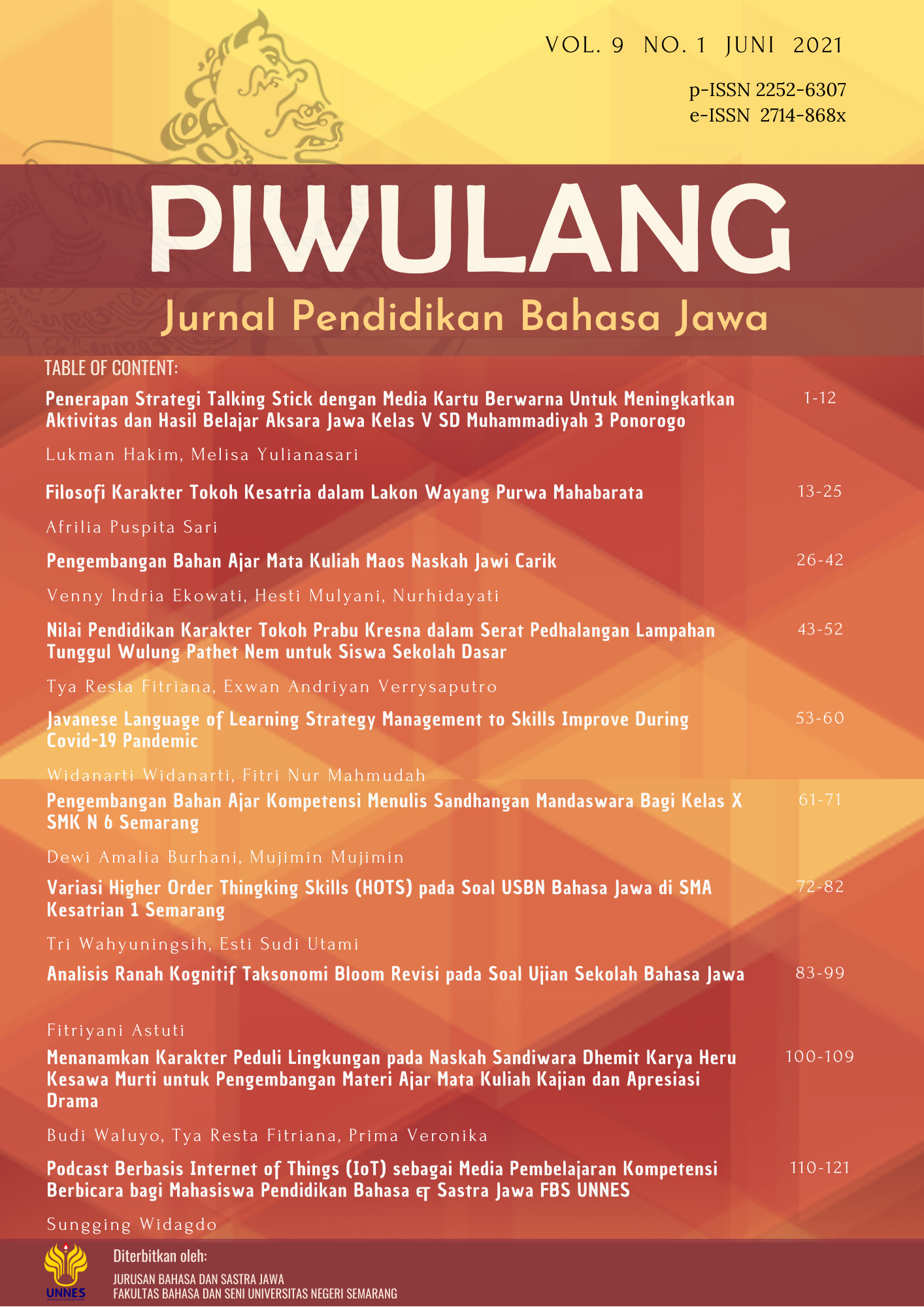Podcast Berbasis Internet of Things (IoT) sebagai Media Pembelajaran Kompetensi Berbicara bagi Mahasiswa Pendidikan Bahasa & Sastra Jawa FBS UNNES
##plugins.themes.academic_pro.article.main##
Abstract
This research was conducted to solve problems related to the Javanese speaking skills of PBSJ FBS UNNES students. For this reason, the development of IoT-based teaching media through podcasts is believed to be able to overcome these learning problems. Moreover, the development of the era provides space for the growth of information technology as a teaching medium that is easily accessible. Therefore, the formulation of this problem is proposed to answer the validity of research and development of IoT-based teaching media in the Javanese language achieved through R & D adaptation of the Dick, Carey, & Carey model. The results of this study are as follows. (1) IoT media speaking Javanese is able to answer the needs of research targets related to writing skills, creative power, and imagination. (2) Based on the validity test, satisfactory content validity was obtained for the Java language-speaking IoT media. For this reason, the product of this research can be used as teaching material, teaching media, theoretical foundation, as well as a reference for lecturers, students, or other researchers.
##plugins.themes.academic_pro.article.details##
References
Brady, Josephin dan Elaine Millard. 2012. “Weaving New Meanings: Evaluating Children’s Written Responses to a Storry Telling Resource Package”. Literacy UKLA Jounal 2012. Vol. 3 No. 6, Hal. 237 s.d 244.
Nurgiyantoro, Burhan. 1995. Penilaian dalam Pembelajaran dan Sastra. Yogyakarta: BBFE.
Desmon, Caroline. 2019. “The Transpormative Potential of Digital Media & Technology on Class Action”. LCB Article. Vol. 23.2: 742-784.
Dick, Walter. Lou Carey., dan James O. Carey. 2009. The Systematic Design of Instruction. Pearson Publishing.
Fu, Lihua. 2018. “Learning on the Influence of Media Industrialization Management Mode on College Students' Ideological Education under the Background of New Media”. Educational Sciences Theory and Practice. Vol. 18. 6: 3219-3229.
Geoghan, M.W., & Klass, D. 2007. Podcast Solution: The Complete Guide to Audio and Video Podcasting. New York: Apress.
Guo, Minghui & Zhu, Wujing. 2018. “Application of New Media Technology in Vocabulary Learning of College English Curriculum”. Educational Sciences Theory and Practice Journal. Vol. 18.6:3376-3383
Murtafiah, Wasilatul; Sa’dijah, Cholis; Chandra, Tjang; Daniel, Chandra; & Susiswo. 2019. “Decision making of the Winner of the National Student Creativity Program in Designing ICT-based Learning Media”. TEM Journal. Vol.8.3: 1039-1045.
Permendikbud No. 109. 2013 Tentang Penyelenggaraan Pendidikan Jarak Jauh Pendidikan Tinggi. Depdikbud.
Permendikti No. 50 Tahun 2018. Tentang Standar Nasional Pendidikan Tinggi (SN-Dikti). Jakarta: kemenristekdikti.
Prihatmoko, D. 2016. “Penerapan Internet of Things (Iot) dalam Pembelajaran”, Jurnal SIMETRIS. Hal. 567-574.
Utami, S.E, Endang Kurniati, Maria Johana AW, Lispridona Diner. 2019. ”The Learning of Social Multistatus Character Genre to Improve Politeness In Javanese Language”. International Journal of Language Education. Vol. 3 No. 2. Oktober 2019. Hal. 9-19.
Zhao, Qiuying & Li, Hailong. 2018. “Application of New Media Technology in College English Vocabulary Teaching”. Educational Sciences Theory and Practice. Vol. 18.6: 3591-3598.
